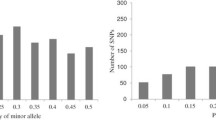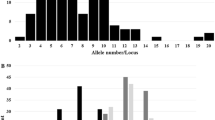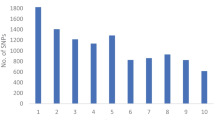Abstract
Molecular markers are useful for determining relationships and similarity among inbreds, especially if the proportion of marker loci with alleles common to inbreds i and j is partitioned into: (1) the probability that marker alleles are identical by descent (Mfij); and (2) the conditional probability that marker alleles are alike in state, given that they are not identical by descent (θ ij). Our objectives were to: develop a method, based on tabular analysis of restriction fragment length polymorphism marker data, for estimating Mfij, θ ij, and the parental contribution to inbred progeny; validate the accuracy of the method with a simulated data set; and compare the pedigree-based coefficient of coancestry (fij) and Mfij among a set of maize (Zea mays L.) inbreds. Banding patterns for 73 probeenzyme combinations were determined among 13 inbreds. Iterative estimation of Mfij, θ ij, and the parental contribution to progeny was performed with procedures similar to a tabular analysis of pedigree data. Deviations of Mfij from pedigree-based fij ranged from 0.002 to 0.288, indicating large effects of selection and/or drift during inbreeding for some inbreds. Differences between marker-based estimates and expected values of parental contribution to inbred progeny were as large as 0.205. Results for a simulated set of inbreds indicated that tabular analysis of marker data provides more accurate estimates of Mfij and θ ij than other methods described in the literature. Tabular analysis requires the availability of marker data for all the progenitors of each inbred. When marker data are not available for the parents of a given inbred, Mfij and θ ij may still be calculated if parental contributions to the inbred are assumed equal to their expectations.
Similar content being viewed by others
References
Bernardo R (1993) Estimation of coefficient of coancestry using molecular markers in maize. Theor Appl Genet 85:1055–1062
Bernardo R (1996a) Best linear unbiased prediction of maize singlecross performance. Crop Sci 36:50–56.
Bernardo R (1996b) Best linear unbiased prediction of maize singlecross performance given erroneous inbred relationships. Crop Sci 36: (Jul-Aug issue)
Cowen NM, Frey KJ (1987) Relationship between genealogical distance and breeding behavior in oats (Avena sativa L.) Euphytica 36:413–424
Dudley JW (1994) Comparison of genetic distance estimators using molecular marker data. In: Analysis of molecular marker data. Proc Joint Symp Am Soc Hort Sci/Crop Sci Soc Am, 5–6 Aug 1994, Corvallis, Oregon, USA, pp 3–7
Efron B (1981) The jackknife, the bootstrap, and other resampling plans. Soc Ind Appl Math, Philadelphia, Pennsylvania
Emik LO, Terrill CE (1949) Systematic procedures for calculating inbreeding coefficients. J Hered 40:51–55
Hallauer AR (1990) Methods used in developing maize inbreds. Maydica 35:1–16
Hunter RB (1989) ASIA approach on minimum distance. Corn Sorghum Industry Res Conf 44:193–195
Lorenzen LL, Boutin S, Young N, Specht JE, Shoemaker RC (1995) Soybean pedigree analysis using map-based molecular markers: I. Tracking RFLP markers in cultivars. Crop Sci 35:1326–1336
Lynch M (1988) Estimation of relatedness by DNA fingerprinting. Mol Biol Evol 5:584–599
Malécot G (1948) Les mathématiques de l'hérédité. Masson et Cie, Paris
Melchinger AE, Messmer MM, Lee M, Woodman WL, Lamkey KR (1991) Diversity and relationships among U.S. maize inbreds revealed by restriction fragment length polymorphisms. Crop Sci 31:669–678
Murigneux A, Barloy D, Leroy P, Beckert M (1993) Molecular and morphological evaluation of doubled haploid lines in maize. 1. Homogeneity within DH lines. Theor Appl Genet 86:837–842
Panter DM, Allen FL (1995) Using best linear unbiased predictions to enhance breeding for yield in soybean: I. Choosing parents. Crop Sci 35:397–405
Souza E, Sorrells ME (1989) Pedigree analysis of North American oat cultivars released from 1951 to 1985. Crop Sci 29:595–601
Author information
Authors and Affiliations
Additional information
Communicated by P. M. A. Tigerstedt
Rights and permissions
About this article
Cite this article
Bernardo, R., Murigneux, A. & Karaman, Z. Marker-based estimates of identity by descent and alikeness in state among maize inbreds. Theoret. Appl. Genetics 93, 262–267 (1996). https://doi.org/10.1007/BF00225755
Received:
Accepted:
Issue Date:
DOI: https://doi.org/10.1007/BF00225755




